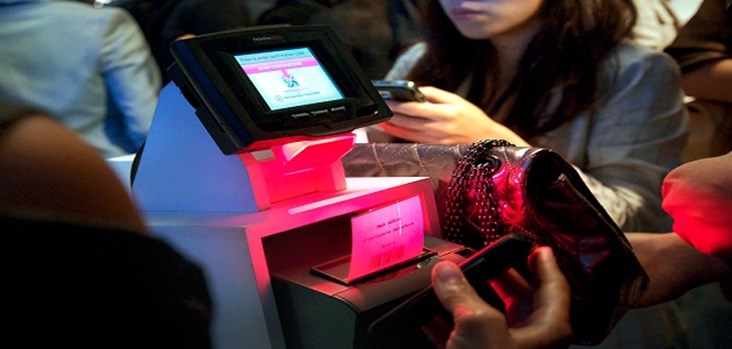60 Years Since the Barcode Patency: The Technology that Paved the Way for an Unprecedented Commercial Revolution
Back
On the morning of June 26 1974, in Marsh store in Ohio, US, Clyde Dawson picked up a 10-pack of Wrigley’s juicy fruit gum from his shopping cart, and handed it over to the cashier Sharon Buchanan who passed it in front of a laser scanner marking the first commercial use of the barcode.
5 weeks after barcode scanners were installed, sales went up by 10 to 12 percent, meanwhile stock operating costs were downed by 1 to 2 percent, which in turn caused prices to drop. Revenues from investment in barcode scanners reached 41.5%, and by 1980, around 8000 stores were converting per year.
What is this revolutionary technology, where does it originate from, how does it work, and how did it conquer every commercial sector across the globe?
The first verified step towards the Barcode, was a trial carried out by Wallace Flint, a graduate of Business Administration at Harvard University, when he wrote a paper in which he explained the use of an automated checkout system to track the flow of goods from the shelves via punched cards in 1932, however the looming Great Depression has forced the idea to be archived until further notice.

The barcode system as we know it is the brainchild of Bernard Silver, a Drexel Institute of Technology graduate, and his friend Norman Joseph Woodland. Bernard concocted the system while he was heading Food Fair chains in his native Philadelphia in 1948.
The pair instituted a goods scanning mechanism using ultraviolet sensitive ink. The prototype however proved to be too expensive and the system was abandoned. They went back to the drawing board and on the 20th of October 1949, they filed for a patent for their barcode technology at the United States Patent and Trademark Office. The patent was granted 2 years later on the 7th of October 1952.
There were some attempts at utilizing barcode technologies during the 60s, when David Collins, a graduate student at the Massachusetts Institute of Technology, attached barcodes to railway cars in order to automatically identify companies and trains, and also to automatically log departure and arrival schedules. This system proved too expensive and too unstable to be pursued.
Barcodes were not commercially used up until 20 years later, since laser technology was not around for that time. IBM, with Woodland’s help, developed the barcode system, Universal Product Code, to overcome printing problems associated with the first generation of barcodes.
Neither Silver, who passed away in an automotive accident in 1963, nor Woodland reaped any monetary benefits from the system's huge commercial success, as they had sold the technology for cheap for a company named Philco (now a part of Philips) in 1962, which later sold it to the Radio Corporation of America. The patent has expired 17 years later, according to the US laws at the time.
What is a Barcode?

Traditionally, barcodes represents data by the varying widths between black parallel bars - those were known as linear or one-dimensional. Later representations used rectangles, dots, hexagons and other geometric patterns - two dimensional codes.
The number of digits varies between 5 and 13, which allows some models theoretically to form up to a billion combinations of numbers. This number of combinations seems quite large considering that part of the digits, usually 5 or 6, represents one company, while an equal number of digits encode one of this specific company’s products.
There are over 5 million unique barcodes available in the world right now according to GS1, an international non-profit association dedicated to improving the efficiency and visibility of supply and demand chains. The most popular barcode symbology is Code 128, which can hold a large amount of data in a relatively small margin (high density), as opposed to Code 39, which only utilizes combinations of letter, numbers (0 to 9) and a few symbols.

How do barcodes work?
When the laser hits the barcode, black bars absorb the light and only the white spaces are reflected onto the reader, which then determines the width of these slots to decipher the code. The data is then sent to a computer which matches it to its database and relates information to it such as the price, the name of the producer, stock quantity available, etc.
An accompanying number is printed just below the barcode, which could be manually inputted by the cashier. Albeit being a slower process, it is used in the case where the scanning fails.
Uses and benefits
Barcodes helped spread the concept of Automated Identification and Data Capture. Its benefits are numerous and spread across a multitude of industries in retail and wholesale, including weight scales in groceries, warehousing, shipping goods, mail, healthcare, passports, entertainment ticketing, transportation, parking tickets, membership cards, loyalty cards, banking cards, library shelving, official documents, nuclear waste, and car plates to name a few.
This new technology brought forth an unprecedented commercial revolution. Both consumers and owners drew massive benefits, since it provided accurate data on inventory that allowed shops to quickly accommodate customer needs and behaviors, identify and increase supply of in-demand products and give them more exposure on the shelves, as well as reduce production of not so popular items. It helped provide better market research and sales forecasts, and consequently more timely discounts and promotions. It allowed better tracking of rented cars and travel luggage. It simplified medical records and schedules for hospital patients, provided better monitoring of employees work hours, prevented faking tickets, shoplifting, and allowed shops to alter prices with a simple modification to the database.
Consumers on the other hand spent a lot less time at the counter; cashiers could not manipulate prices any more; and loyalty programs became more commonplace as they were easier to implement and track.
Barcodes had scientific applications as well. For instance, scientists used them to monitor the mating habits of bees.
Despite its popularity, some wineries still refuse to implement barcodes in their industry for aesthetic purposes.


Barcodes even made a mark in the art scene, with pop singer Pink tattooing her back of the neck with a remarkable barcode, while artist Scott Blake used it in his piece “Barcode Jesus”, a piece of the post-modernist movement.
Some suggest that the barcode is equivalent to capitalism and consumerism.
Why is the barcode famous?
Barcodes became popular because of their ease of use, cheap implementation: either purchasing the codes from GS1 or the laser scanners, in addition to their low error rate.
Barcodes still represent a much less costly alternative to RFID technology, another automated and data capture technology.
Barcodes differ from serial numbers in that the latter identifies individual products, be it electronics, banknotes or books, in the case of ISDN. Serial numbers limit forged items, help tracking products in case of theft, and facilitate quality control.
Variations of the same code

ArabNet Riyadh's registration page in the form of a QR code
Most smartphones today are able to scan barcodes and quick response (QR) codes, a technology developed by Toyota in 1994.
While barcodes are used for store cashiers and databases, quick response codes are a multi-data vessel. They can accommodate digital data, alphanumeric data, in addition to complex Japanese letters (kanji). Technically, both codes can be mixed together.
QR codes are represented by a matrix of dots, and can contain more data than the traditional barcodes.
As of late, QR codes have been increasing in popularity, and have become a widely used form of 2D codes. Similar to other 2D codes, QR codes can be read using a scanner or a digital camera. QR codes can contain URLs, images, video, or simply any type of digital data or media. Despite 2D codes not being strictly represented in a linear fashion, the term barcode still applies to them.
It is interesting to note that the 10-pack of the Wrigley’s juicy fruit gum and the receipt from the first commercial application of the barcode can still be found at the Smithsonian Institution in Washington.
Latest Business
Intelligence Report













